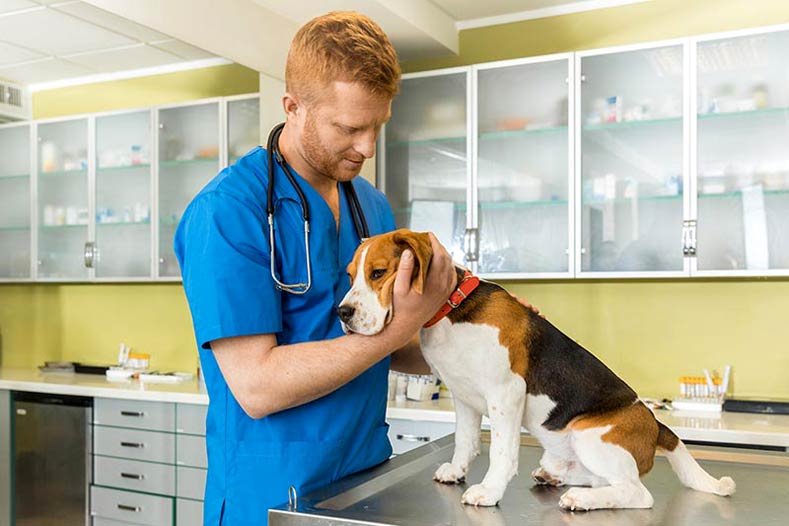What Can Cause Dogs to Have Blood in Their Stool
The first thing you should do if you find blood in your dog's stool, whether the stool is formed or loose (like diarrhea), is to call your veterinarian. You can save yourself and your veterinarian time by knowing how to describe your dog's bloody stool. There are two types: hematochezia and melena.
Hematochezia is bright red blood. This type of bleeding occurs in the lower digestive tract or colon and indicates a specific set of conditions.
If you notice a single streak of red blood in your dog's stool, and the rest of his poop is normal, it might be a fluke. Consistent bleeding or large amounts of blood indicate a more serious problem. Severe conditions that can cause bloody stool or bloody diarrhea include viral and bacterial infections, parvovirus, hemorrhagic gastroenteritis, and possibly cancer.
Melena is a dark, sticky, tarry stool, almost jelly-like. This blood has been digested or swallowed, indicating a problem in the upper digestive tract.
Some dogs have darker stool than others, depending on diet and other factors. If it looks darker than normal or shows any major changes in color or appearance, contact your veterinarian. Causes include parasites and liver cancer.
Other Symptoms
Keep an eye out for changes in your dog's appetite, activity levels, and attitude. Vomiting, diarrhea, appetite loss, weakness, blood in the urine, and difficulty breathing can all indicate serious conditions that require immediate veterinary intervention.
Blood belongs in blood vessels, so when it makes an appearance anywhere else on or around our pets, we worry — and with good reason. Blood in dog stool is a symptom of a wide range of conditions. Some are more serious than others, but knowing what you're looking at can help you communicate more clearly with your veterinarian.
Blood in Dog Stool
The first thing you should do if you find blood in your dog's stool, whether the stool is formed or loose (like diarrhea), is to call your veterinarian. Dogs can't verbalize when they aren't feeling well. Finding blood in dog poop is alarming, and it's also a clear sign that something is going on with your pup.
You can save yourself and your veterinarian time by knowing how to describe your dog's bloody stool. There are two types: hematochezia and melena.
Hematochezia is bright red blood. This type of bleeding occurs in the lower digestive tract or colon and indicates a specific set of conditions.
Melena is a dark, sticky, tarry stool, almost jelly-like. This blood has been digested or swallowed, indicating a problem in the upper digestive tract. You can check whether your dog's stool contains this kind of blood by wiping it on a paper towel to see if the color is reddish.

Bright Red Blood in Your Dog's Stool
Bright red blood looks dramatic, but it isn't always a sign of a life-threatening illness. If you notice a single streak of red blood in your dog's stool, and the rest of his poop is normal, it might be a fluke. But you should still call your veterinarian. Consistent bleeding or large amounts of blood, on the other hand, indicate a more serious problem.
Here are some of the more common causes of bloody stool in dogs:
- Colitis (inflammation of the colon)
- Parasites, such as hookworms
- Trauma
- Toxins
- Inflammatory bowel disease
- Anal sac infections or impactions
Severe conditions that can cause bloody stool or bloody diarrhea include viral and bacterial infections, parvovirus, hemorrhagic gastroenteritis, and possibly cancer. Your veterinarian may perform a series of diagnostic tests (such as a fecal examination and possibly blood work) to help determine the cause of the bleeding, but if you think your unvaccinated dog may have been exposed to parvovirus, call ahead before you bring him into the emergency room to help the staff limit the spread of infection.
Dark, Tarry Stools
Dark, tarry stools are often more difficult to notice than bright red blood. Some dogs have darker stool than others, depending on diet and other factors. You know your dog's poop. If it looks darker than normal or shows any major changes in color or appearance, contact your veterinarian.
Possible causes of melena in dogs include:
- Parasites
- Inflammatory disorders
- Infections
- Ulcers
- Tumors
- Foreign bodies and trauma
- Kidney failure
- Exposure to toxins
- Addison's disease
- Liver disease
- Pancreatitis
- Hormonal imbalances
- Clotting disorders
- Reaction to certain medications, such as anti-inflammatory medications

If your dog is suffering from one of these conditions, he might show other symptoms, as well. Keep an eye out for changes in your dog's appetite, activity levels, and attitude. Vomiting, diarrhea, appetite loss, weakness, blood in the urine, and difficulty breathing can all indicate serious conditions that require immediate veterinary intervention. If your dog shows these signs for the first time and is on any medication, stop the medication at once and call your veterinarian immediately.
Now that you have a basic understanding of the possible causes of bloody stool and how to describe your dog's condition, contact your veterinarian. As with all other medical conditions, the sooner you get your dog examined, the better.
What Can Cause Dogs to Have Blood in Their Stool
Source: https://www.akc.org/expert-advice/health/blood-in-dog-stool/